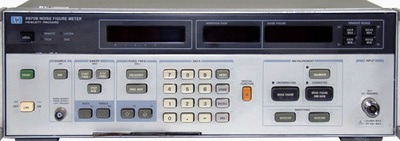
|
|
The HP 8970B is an automatic noise figure meter with RF and microwave capabilities. Because the Agilent 8970B acts as a controller for local oscillators, broad-band measurements of microwave devices is simplified to the level of RF. Noise figure measurements are sensitive to -100 dBm and any IF between 10 and 1600 MHz may be used. Measurements can be made at a rate of 6 to 9 measurements per second with minimal smoothing. The 8970B can store up to five ENR (Excess Noise Ratio) calibration tables, with four in memory, and one active table. Each table can hold up to 35 entries that are used to correct for ENR vs frequency variations. For measurements made between calibration points, ENR data is interpolated. Automatic second-stage correction makes accurate noise figure readings possible even for low-gain devices. The HP 8970B measures its own noise figure as well as the entire measurement system at up to 181 points in one sweep. This information is stored and interpolated, removing second-stage effects. The gain of the DUT is also measured for improved accuracy. Noise figure measurements can be made across a power range of 0 to 30 dB, with an instrumentation uncertainty of +/- 0.1 dB from 0 to 55 degrees C and ENR of 14 to 16 dB. Readings can be made in units of dB or as a ratio, or uncorrected Y-Factor in dB or as a ratio, or effective input noise temperature in kelvins. Noise figure measurements can be made to a resolution of 0.01 dB, or 0.001 dB over HP-IB. Display jitter falls under 0.01 dB with appropriate smoothing. The HP 8970B's dynamic range allows it to measure gain up to 40 dB or loss to -20 dB without external attenuation or amplification. The uncertainty of gain measurements falls within +/- 0.15 dB of readings. Gain measurments can be made with a resolution of 0.01 dB for gain >= -9.99 dB, and 0.1 dB for gain < -9.99 dB, or alternatively 0.001 dB over HP-IB. The input frequency is tunable from 10 to 1600 MHz. Tuning is accurate to +/- (1 MHz + 0.01 x freq.), with a maximum of +/- 6 MHz. The internal frequency resolution is 1 MHz. The internal noise figure for input power levels below -60 dBm is below 7 dB + 0.003 dB/MHz. The maximum operating input power is -10 dBm. The maximum possible external gain between the noise source and the RF input is 65 dB. The noise source drive level is at 28.0 +/- 0.1 volts. The input SWR (reflection coefficient) is below 1.7 with a 50 ohm reference impedance.
|